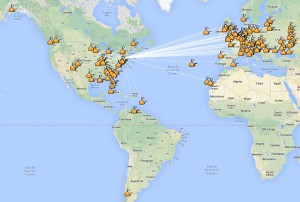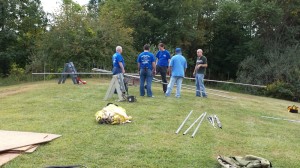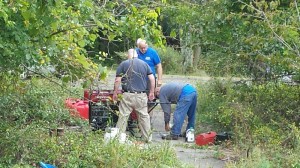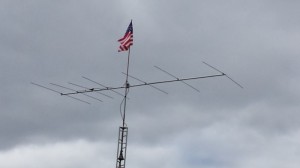This years CQ WW RTTY contest was my first real contest after getting back on the air with a shiny new NA4RR hex beam to replace my wire dipoles taken down from Hurricane Sandy. I operated low power (100 watts) and non-assisted (no DX cluster).
Friday:
Friday night some friends came over and other than showing how it worked, I didn’t operate the first 3 hours of the contest and got started at 11pm ET (0300z). I operated until 1:30am (0530z) on 40m and 80m and ended up with 95 Qs before heading to bed for 5 hours.
Saturday:
Saturday morning I took a quick spin through 80m and then 40m. I heard a couple JAs on 40m but they couldn’t hear me. I switched to 20m for 1 hour mainly work EU stations. I popped into the shower and then back in the chair on 10m. I was ecstatic to see 10m open and there was a lot of activity – 90 mins worth! I worked two Saudi Arabia stations on 10m including HZ1PS who sent a real nice personal message. I later worked HZ1PS again on 20m on Sunday and he sent another nice personal message. Thanks Peter!!
I also worked Oman on 10m and with 200 Qs logged in the contest, I stopped operating for 2 hours and went over to our clubs Portable Day at a county park about 20 mins away. They had 7 different stations setup within walking distance using portable power with wire antennas strung on poles and trees. One station was running just 3 watts into a wire antenna in a tree and on 10m had a nice QSO with Sardinia like they were standing next to us. Another station was running a KX3 connected to a netbook making some CW WW RTTY contacts on 10m with a wire running between a pole and a tree branch. The weather was gorgeous and everyone was having a blast.
I got back on the air about 2.25 hours later, made some contacts on 10m and then switched to 15m which was hopping. 90 mins later of S&Ping EU and SA stations I took a quick look on 10m and logged some new stations. I switched over to 20m and spent over 1 hour there spinning up and down the dial logging anything I could hear. Around 4:30pm ET (2030z) I switched back again to 10m and came up a New Zealand station. I headed back to 15m and pointed Northwest as it was time for the JAs to start coming in and within 30 mins they were coming in as I tuned the dial. I’d sneak back to 10m from time to time and see if anyone knew was calling CQ before heading back to 15m. On one switch back to 15, I went up to the top of the band to work my way down and there was a Korean station coming in just calling CQ. I listened twice to make sure I printed it correctly, and when it came back HL2WP again I sent my call and he came back to me. I sent my exchange, he asked for a repeat on the state which I sent, and then I got his QSL. I just logged my first Korea contact! I stayed on the frequency seeing if anyone else would show up as he kept calling CQ but after 1 minute with no one else coming back to him I tuned away.
I spent the remainder of Saturday on 20m before heading to 40m and 80m, popping back to 20m from time to time. One of the contacts on 80m sent a nice message about my blog – thanks N1QD (Joe)! I called it a night about 11:30p ET (0330z) with 511 Qs in the log.
Sunday:
Woke up a bit later and got on about 7am (1100z) and spun through 80m and 40m logging over 30 stations, mostly in the US, but necessary state multipliers. I then switched to 15m and spent 2 hours working the band logging new multipliers such as Georgia, Iceland, Surinam (‘ol reliable PZ5RA). I switched to 10m for a short while, back to 20m and then back to 10m. Around 11:50am ET (1550z) , 10m got very quiet. The activity dropped considerably. I spent the rest of the day on 15m and 20m popping back to 10m from time to time. Though there were some new stations on 10m, it was much less after than on Sat and Sun morning until just before noon. Good thing 15m was hopping as the band was full from below 21080 up to 21150. As quick as you could nudge the dial there was another station to log.
On 1 band switch from 20m back to 15m, I entered 21125 into N1MM to tune to that frequency so I could see how far up the band stations still were. I could just hear a station calling CQ. I sent my call and I got an immediate reply. I sent my report and received a TU so 5W1SA on Samoa was in the log. At the time I thought that was another all time new one for me (like Korea) but I had previously logged another station a couple of years ago. Still, I was thrilled and I stayed on frequency to see if anyone else came along. After a few more CQs, N2QT came on frequency, sent out his call and exchange and I went on my way.
As it got dark out, I hopped on 40m and 80m, worked stations, ran a bit, worked some more stations, ran a bit more, and then the contest ended. I wrapped up with 895 Qs and 847k points which is a bit down from the previous year. But it was a fantastic contest and I took some time out for friends, visit club members at the park, and to keep an eye on the NY Giants play horrible football for 4 games in a row. It was great to be back on the air and making contacts with so many familiar calls again.
Here’s my N1MM score summary:
Band QSOs Pts ZN DXCC State
3.5 90 123 9 12 32
7 161 260 14 30 37
14 240 600 19 54 31
21 284 742 21 61 22
28 120 326 16 50 5
Total 895 2051 79 207 127
Score : 847,063
Here’s a map of the contacts made using ADIF2MAP (click for a larger picture):
Here are some stats:
DXCCs worked: 82
DXCCs worked with just 1 contact: 22
Mainland US states worked: 43
Unique stations worked: 631
Stations worked on 5 bands: 6
Stations worked on 4 bands: 14
Stations worked on 3 bands: 40
Stations worked on 2 bands: 98
Top 5 entities worked – name / # Qs / % total:
United States – 273 – 30%
Germany – 57 – 6%
Canada – 54 – 6%
Italy – 43 – 5%
Spain – 30 – 3%
Thanks again to everyone for participating and I can’t wait for the next contest!
73,
K2DSL





















